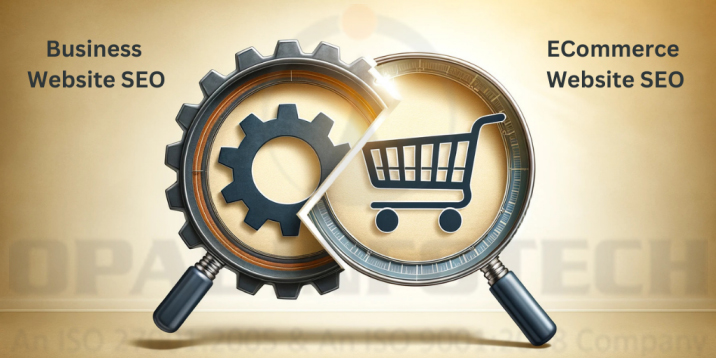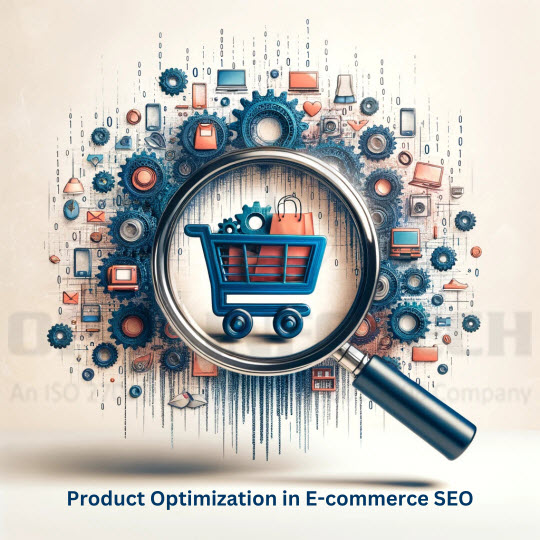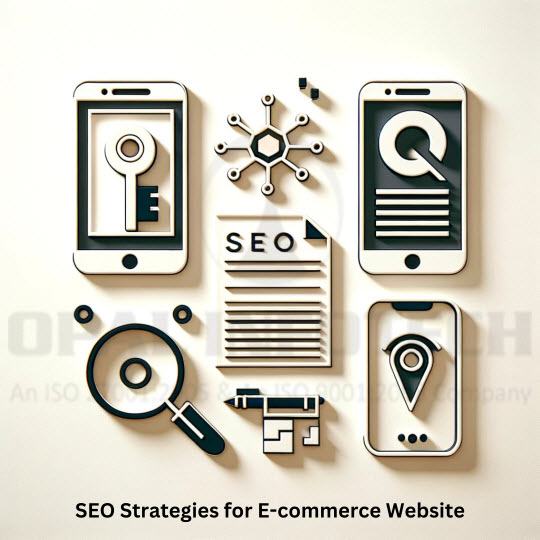E-commerce has revolutionized the way businesses operate, providing opportunities to reach a global customer base and achieve remarkable growth. When it comes to optimizing an e-commerce website for search engines, there are distinct differences compared to traditional business websites. Understanding these nuances is essential for businesses aiming to maximize their online visibility and drive relevant traffic. We will explore how e-commerce SEO differs from business website SEO, highlighting key strategies, challenges, and techniques specific to e-commerce optimization. By delving into this topic, businesses can gain valuable insights to enhance their SEO efforts and achieve success in the competitive e-commerce landscape.
ECommerce Website SEO Vs. Business Website SEO
When it comes to SEO, there are some key differences between optimizing an eCommerce website and a traditional business website. In eCommerce SEO, the focus is on optimizing product pages, category pages, and other pages related to the products being sold. The goal is to improve visibility on search engines and drive organic traffic to these pages.
One difference is the emphasis on keyword research. While traditional business websites may focus on keywords related to their services or industry, eCommerce SEO requires keyword research that is specific to the products being sold. This includes long-tail keywords that capture specific product details, features, or variations.
Another difference is the importance of product descriptions. In eCommerce SEO, product descriptions play a crucial role in attracting search engine traffic. These descriptions should be unique, and informative, and include relevant keywords to help search engines understand the product’s context and relevance.
ECommerce SEO involves optimizing product images. This includes using descriptive file names and alt tags that accurately describe the image content. Optimizing image sizes for faster loading times can also enhance the user experience and improve search engine rankings.
Implementing structured data markup is essential in eCommerce SEO. This helps search engines understand the content on a webpage, including product names, prices, reviews, and availability. By providing this structured data, search engines can display rich snippets in search results, which can improve click-through rates.
E-commerce SEO often involves optimizing for local search. This is particularly important for businesses with physical stores or multiple store locations. Local SEO strategies can include creating location-specific landing pages, optimizing Google My Business profiles, and ensuring consistent business information across online directories.
Overall, while there are similarities between eCommerce SEO and traditional business website SEO, there are distinct differences due to the unique nature of eCommerce platforms and the focus on product optimization.

Basics of E-commerce SEO
When it comes to e-commerce websites, search engine optimization (SEO) is essential for increasing visibility and driving organic traffic. E-commerce SEO involves optimizing product pages, improving website structure, and implementing strategies to enhance the overall user experience. The goal is to rank higher in search engine results and attract potential customers who are actively looking for products to purchase.
Exploring the Fundamentals of Business Website SEO
Business websites, on the other hand, may have a broader focus beyond just selling products. They aim to promote a company’s services, provide information, and establish credibility. Business website SEO involves optimizing service pages, creating informative content, and building backlinks to improve search engine rankings. The objective is to generate leads and convert visitors into customers.
Key Differences in E-commerce SEO and Business Website SEO
Focus on Product Pages in E-commerce SEO
In e-commerce SEO, the primary focus is on product pages. Each product needs to have its own optimized page with unique content, relevant keywords, and persuasive descriptions. It’s crucial to showcase the product’s features, and benefits, and use high-quality images. Additionally, optimizing the product titles, meta descriptions, and URLs is essential to improve visibility in search results.
Emphasis on Service Pages in Business Website SEO
Unlike e-commerce websites, business websites often prioritize service pages. These pages provide detailed information about the services offered, target specific keywords, and include calls to action to encourage conversions. Optimizing service pages involves crafting compelling headlines, providing clear descriptions, and incorporating relevant keywords. Building a strong internal linking structure within the website is also important to enhance navigation and improve SEO.
Importance of Product Optimization in E-commerce SEO
Optimizing Product Descriptions for Search Engines
One crucial aspect of e-commerce SEO is optimizing product descriptions. These descriptions should be unique, engaging, and informative. Keyword research plays a vital role in identifying relevant terms to include in the descriptions. By incorporating these keywords naturally, you can improve the chances of your products appearing in relevant search queries. It’s also important to regularly update and refine product descriptions to stay competitive in search rankings.
Using Schema Markup and Rich Snippets in E-commerce SEO
To further enhance visibility and user engagement, e-commerce websites can leverage schema markup and rich snippets. Schema markup is a structured data vocabulary that helps search engines understand the relevance of your content. By using schema markup, you can provide additional information about your products, such as price, availability, and reviews. This information can be displayed as rich snippets in search results, making your listings more attractive and informative to potential customers.

Unique Challenges in E-commerce SEO
Dealing with Large Product Inventories
One of the challenges in e-commerce SEO is managing large product inventories. With numerous products, it can be challenging to create unique and optimized content for each item. To overcome this, it’s important to prioritize product pages based on popularity, profitability, or strategic importance. Focus on optimizing high-priority products and ensure they have compelling descriptions, relevant keywords, and high-quality images.
Managing Duplicate Content in E-commerce SEO
E-commerce websites often face the issue of duplicate content due to product variations or similar descriptions. Search engines may penalize websites with duplicate content, affecting visibility in search results. To tackle this, implementing canonical tags and utilizing parameter handling tools can help identify the source of content. Additionally, ensuring that each product variation has unique attributes and descriptions can minimize the impact of duplicate content on SEO.
Whether you’re optimizing an e-commerce website or a business website, SEO is all about providing a great user experience, and relevant content, and making it easy for search engines to understand your website.
Strategies for E-commerce SEO Success
When it comes to e-commerce SEO, there are a few key strategies that can make all the difference in boosting your online visibility and driving more traffic to your online store. One of the first things you’ll want to focus on is implementing keyword research and analysis. By understanding what your target audience is searching for, you can optimize your product descriptions and metadata to match their queries. By aiding search engines in grasping the relevance of website content, it will optimize your chances of achieving a higher ranking in search results.
Another important aspect of e-commerce SEO is building high-quality backlinks. Backlinks are essentially other websites linking to your online store. When reputable sites link to yours, it signals to search engines that your site is trustworthy and valuable. By actively seeking out relevant websites for backlink opportunities, you can improve your site’s authority and visibility.

Maximizing Conversion Rates in E-commerce SEO
Once you’ve successfully attracted visitors to your online store, the next step is to focus on converting them into paying customers. One way to do this is by optimizing the user experience and site speed. Slow-loading pages and clunky navigation can turn potential customers away, so it’s essential to ensure your website is fast, responsive, and easy to navigate.
Another effective strategy for maximizing conversion rates is implementing effective call-to-actions (CTAs). Whether it’s adding compelling buttons that prompt users to make a purchase or offering discounts and incentives, CTAs can significantly impact your conversion rates. By strategically placing CTAs throughout your site, can guide users through the buying process and increase your chances of making a sale.
Tools and Techniques for E-commerce SEO
To make e-commerce SEO efforts more efficient and effective, there are a variety of tools and techniques you can utilize. SEO plugins and extensions are one such example. These handy tools can help you optimize your website’s content and structure, making it easier for search engines to understand and rank your site.
Tracking and analyzing SEO performance with tools like Google Analytics is crucial. By monitoring key metrics such as traffic sources, bounce rates, and conversion rates, you can gain valuable insights into how your SEO strategies are performing. This data can then be used to refine your approach and make data-driven decisions to improve the online store’s visibility and profitability.
The Future of E-commerce SEO
As search engine algorithms continue to evolve, it’s vital for e-commerce SEO strategies to adapt as well. Staying up to date with the latest algorithm changes and trends is crucial for maintaining and improving your online store’s visibility.
Exploring emerging trends in e-commerce SEO, such as voice search optimization or mobile-first indexing, can give you a competitive edge and help you reach more customers. By staying proactive and embracing new technologies and strategies, you can position your online store for success in the ever-changing digital landscape. So keep adapting, and experimenting, and always stay one step ahead in the world of e-commerce SEO.
As e-commerce continues to thrive and evolve, the significance of effective SEO practices cannot be overstated. E-commerce SEO requires a unique approach that focuses on product optimization, tackles challenges like large inventories and duplicate content, and prioritizes user experience and conversion rates. By staying updated on emerging trends, harnessing the power of SEO tools and techniques, and adapting to evolving search engine algorithms, businesses can position themselves for long-term success in the ever-growing e-commerce industry. With a strategic and comprehensive approach to e-commerce SEO, businesses can unlock the full potential of their online presence, drive targeted traffic, and ultimately achieve their business objectives.
FAQ’s About E-commerce SEO and Business Website SEO
What is the main difference between Ecommerce SEO and Business Website SEO?
E-commerce SEO primarily focuses on optimizing product pages, while business website SEO emphasizes service pages. E-commerce SEO also involves managing large inventories, dealing with duplicate content, and maximizing conversion rates to drive sales.
How can I optimize product descriptions for e-commerce SEO?
To optimize product descriptions, it is important to include relevant keywords, provide unique and informative content, highlight product features and benefits, and utilize structured data markup like schema.org to enhance visibility in search engine results.
What are some effective strategies for e-commerce SEO success?
Some strategies for e-commerce SEO success include conducting thorough keyword research and analysis, building high-quality backlinks, optimizing site speed and user experience, implementing effective call-to-actions, and regularly tracking and analyzing SEO performance using tools like Google Analytics.
How can businesses adapt to the evolving landscape of E-commerce SEO?
To adapt to the evolving landscape of e-commerce SEO, businesses should stay updated on the latest search engine algorithms and industry trends. They should also be open to testing new strategies, embracing emerging technologies, and continuously optimizing their websites to stay ahead of the competition.





